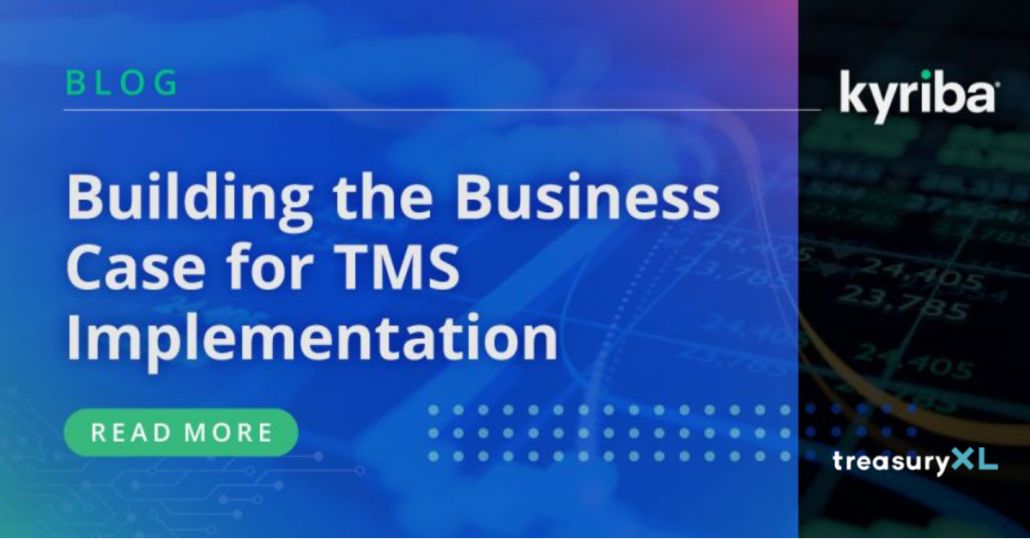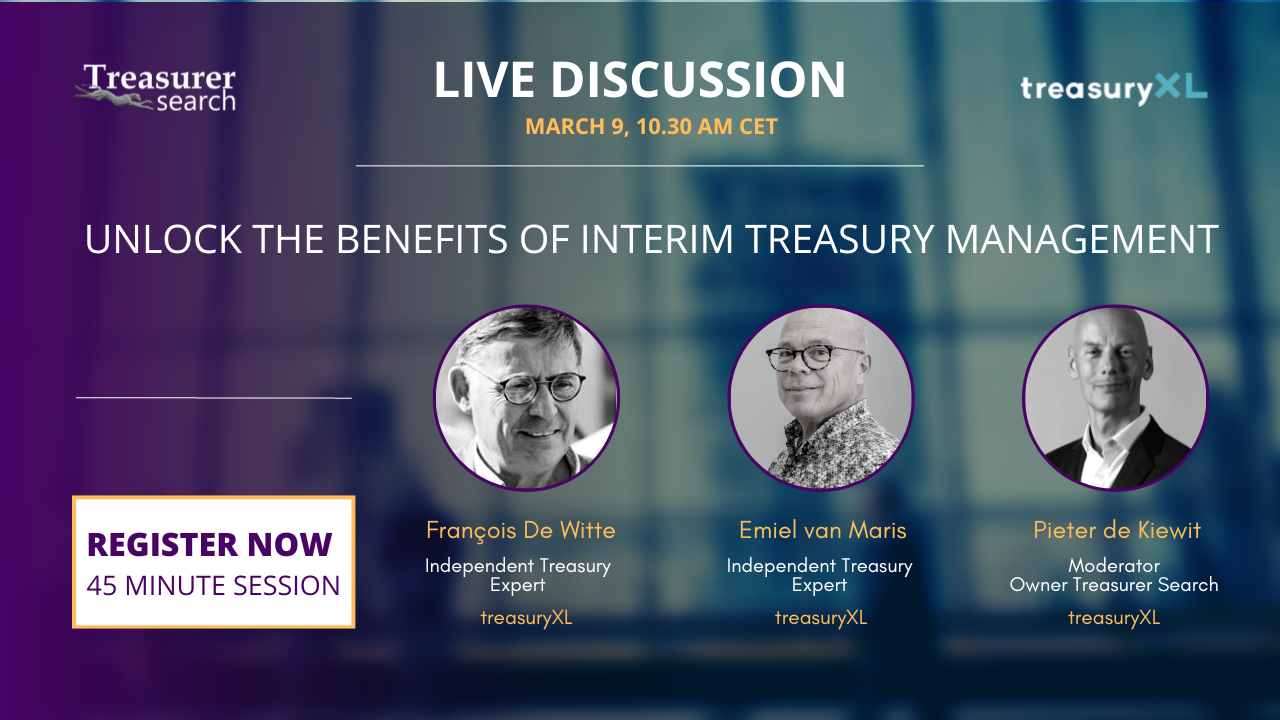Kyriba Day November 9th Utrecht
06-11-2023 | Experience the future of Treasury and immerse yourself!
06-11-2023 | Experience the future of Treasury and immerse yourself!
13-09-2023 | Promising Future & Unlimited Opportunities. Register for Kyriba Live 2023 on October 12 in Paris, France.
02-08-2023 | Cash is still king — but the value of cash and forecasted liquidity held or planned by the company can only be realized via cash visibility, when the treasurer knows what cash is available, where it is held and what flows are expected in the future.
05-07-2023 | Recently we delved into a poll to gain further understanding of how far ahead treasurers do forecast. Are you a master of short-term planning, or do you have your eye on the future? The results are in, find out how you compare with your peers and learn from Conor Deegan of CashAnaltyics what can be learned from this.
29-05-2023 | FX Volatility Leads to Third Largest Quantified Earnings Impact to Date as CFOs Continue to Struggle with Currency Risk
11-05-2023 | Embedded finance is the practice of integrating financial services within non-financial platforms and services with the objective of delivering the financial service at the “point of need”. In the not-so-distant past, accessing financial services such as payments, lending, and investments required either a visit to the bank or a redirection to a financial services provider’s portal or call center.
10-04-2023 | You have completed the necessary legwork and are prepared to propose a treasury management system (TMS) to your CFO. But are you ready to explain the value a TMS will provide your CFO? In this blog, which is part of our Value Engineering series, we will explore why treasury should focus on risk management when building the business case for a TMS.
27-02-2023 | treasuryXL | Kyriba | LinkedIn |
By Andrew Deichler, Content Manager, Strategic Marketing
Convincing the CFO to approve the adoption of a treasury management system (TMS) almost always requires the treasurer to carefully build a strong business case. During a panel session at a recent Kyriba event, treasurers from multiple companies shared their experiences pitching TMS implementations to their finance chiefs.

Building the business case for new treasury technology is a tall order, even if doing so can greatly improve cash and liquidity management, FX risk management, working capital management and more. In times of economic uncertainty and budget tightening, it’s even more challenging. But treasurers can have greater success if they know how to position a treasury solution as a necessity.
Lee-Ann Perkins, assistant treasurer for Specialized Bicycle Components, noted that throughout her career, she has been successful pitching a TMS implementation to a CFO at times when various external factors were in her favor. If the economy was good or the company was performing consistently well, then getting buy-in for treasury technology can be a much easier sell.
Fred Schacknies, treasurer for TechnipFMC, noted that treasurers generally “don’t do a great job” of talking TMS implementations to the CFO. Schacknies speaks from extensive experience, having pitched TMS implementations to four CFOs at four different companies. In his estimation, convincing the CFO generally boils down to showing them what finance and treasury currently cannot do without such a treasury system. “Either it’s helping a critical transformation or it’s not,” he said.
For example, treasury at TechnipFMC manages “a material foreign exchange portfolio,” which is challenging to do with legacy technology, Schacknies explained. While treasury also is well staffed in comparison to the size of the company, it could run more efficiently if certain tasks we automated. So, gaining buy-in from the CFO on a treasury system implementation wasn’t difficult because Schacknies was able to show that it supported key strategic and organizational imperatives.
According to Chris Mitchell, treasury director, technology and operations for Koch Industries, it can also help to provide the CFO with more of a long-term vision rather than just immediate process improvements. When the treasury leadership team presented the case for a TMS implementation to the CFO, they first discussed the benefits of automation. It didn’t move the needle. But when they presented their overall vision and strategy of a treasury department across the world working closer together, the CFO was able to see how a TMS could help. “We needed one single application that could be accessed across the entire globe by a core group of treasury individuals to support our businesses,” he said.
Treasury can also capitalize on timing. Petar Tomicic, treasury manager for Beam Suntory, explained that the 2014 acquisition of Beam Inc. by Suntory created a “perfect storm” for a TMS implementation. The treasury department knew that the legacy system it was using was outdated. After the acquisition, it became immediately clear that the system didn’t have the capacity to handle the growth that the company was expected to experience. So, for Beam Suntory’s treasury, building a business case with the CFO wasn’t difficult because it was absolutely necessary due to the changes the company was experiencing.
It also helps to have allies outside of treasury to support your case. A TMS implementation affects more than just treasury, and it can help immensely if other departments recognize this fact.
Stephen Kincaid, vice president and assistant treasurer for Walker & Dunlop, explained that in 2016, his controller was the one who first suggested investing in a TMS. This occurred right before AFP’s annual conference, which provided the perfect opportunity to meet with various TMS providers.
After speaking with several TMS providers at the conference and ultimately selecting Kyriba, Kincaid and his controller needed approval from the CFO. Fortunately, the CFO agreed because they were able to carefully illustrate why Walker & Dunlop needed to adopt a treasury system. “We had over 1,000 bank accounts with multiple banks, and didn’t have an easy, efficient way to track our cash positioning in real-time,” he said. “Ultimately, my controller was easily able to convince the CFO of the many benefits that a TMS could provide to our organization.”
When Lee-Ann Perkins join Specialized in 2021, she faced a unique challenge. Treasury had already adopted Kyriba, but the project had stalled prior to completing the implementation across the company’s locations around the world. “So, my job was to restart a Kyriba implementation for the rest of the company—in 80 countries,” she said.
Finishing the implementation was critical for Perkins to achieve her overall goals of automating and maturing the treasury department. While Specialized is a large, global company, the treasury team is small. Maintaining continuity—which includes cash visibility and protecting the company’s financial assets—is much easier to do with a treasury solution. But completing the project would require more than just getting the treasury team on board, as well as producing hard numbers.
“The sell to the CFO was to get resources from the financial side and the human capital side to ensure we could keep the implementation going,” she said. “It wasn’t what I would call an easy sell. It required conversations, quantitative metrics and qualitative metrics, to ensure that there was buy-in from the end-users. Because at the end of the day, those people running the system need to also know that they can use it in their particular jobs as well.”
There are a multitude of factors that can contribute to treasury either getting the approval for treasury software implementation or getting shot down. With a possible recession looming and many companies tightening their purse strings, 2023 may be an exceptionally challenging year for treasury departments to get buy-in for a TMS. Treasury must establish the need for a system—not only for itself but across other departments.
Often tasked with doing more with less, treasury has consistently risen to the challenge. But there comes a point where investments need to be made for treasury and the overall business to continue to perform at a high level. If treasury can make that case, then getting buy-in might not be a tall order after all.
23-02-2023 | treasuryXL | LinkedIn |
Download the comprehensive eBook on Treasury function, compiled by treasuryXL. This valuable resource covers a wide range of relevant topics including Treasury, Corporate Finance, Cash Management, Risk Management, and Working Capital Management.
Drawing on the expertise of Treasury professionals and their best practices, we have carefully crafted clear and concise articles that provide you with the most crucial information about the key topics in the world of Treasury.
In this eBook, we take a deep dive into each Treasury function and explore:
Whether you are new to Treasury or an experienced practitioner looking to expand your knowledge, this eBook is an essential resource that will help you stay up-to-date with the latest best practices and insights in the field.
We simply giveaway two presents for you! By signing up for our newsletter you will automatically receive the following in your inbox:
Subscribe, Join, Download and Relax.
Welcome to our community and have fun reading!

Director, Community & Partners at treasuryXL
14-02-2023 treasuryXL | Treasurer Search | LinkedIn
Join us for a thought-provoking Live Session on Interim Treasury Management, where our experts will delve into the pros and cons of this exciting market.
Unlock the Benefits of Interim Treasury Management: Discover Why it’s a Must-Have for Your Business!

Our panel of seasoned interim treasurers, including Emiel van Maris, Francois De Witte, and treasury recruiter Pieter de Kiewit, will share their valuable insights and experiences.
This webinar is designed for aspiring interim managers, potential clients, and anyone interested in learning more about this market.
Don’t miss this opportunity to gain tips and tricks from the experts in the field and engage in an open discussion.
Register now to secure your spot!
Everyone is welcome to this webinar.
🌟Moderator: Pieter de Kiewit of Treasurer Search
🌟Duration: 45 minutes
𝘉𝘺 𝘳𝘦𝘨𝘪𝘴𝘵𝘦𝘳𝘪𝘯𝘨 𝘺𝘰𝘶 𝘤𝘰𝘯𝘴𝘦𝘯𝘵 𝘵𝘰 𝘳𝘦𝘤𝘦𝘪𝘷𝘪𝘯𝘨 𝘤𝘰𝘮𝘮𝘶𝘯𝘪𝘤𝘢𝘵𝘪𝘰𝘯𝘴 𝘧𝘳𝘰𝘮 𝘵𝘳𝘦𝘢𝘴𝘶𝘳𝘺𝘟𝘓 𝘳𝘦𝘨𝘢𝘳𝘥𝘪𝘯𝘨 𝘵𝘩𝘦 𝘭𝘢𝘵𝘦𝘴𝘵 𝘵𝘳𝘦𝘢𝘴𝘶𝘳𝘺 𝘪𝘯𝘴𝘪𝘨𝘩𝘵𝘴. 𝘠𝘰𝘶 𝘮𝘢𝘺 𝘸𝘪𝘵𝘩𝘥𝘳𝘢𝘸 𝘢𝘯𝘺𝘵𝘪𝘮𝘦. 𝘗𝘭𝘦𝘢𝘴𝘦 𝘳𝘦𝘧𝘦𝘳 𝘵𝘰 𝘰𝘶𝘳 𝘗𝘳𝘪𝘷𝘢𝘤𝘺 𝘗𝘰𝘭𝘪𝘤𝘺.
We can’t wait to welcome!
Best regards,

Kendra Keydeniers
Director, Community & Partners